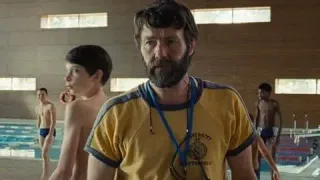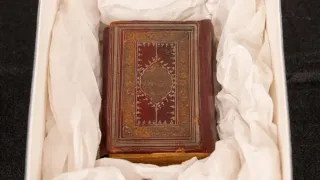June 6, 2023
'Breaking the Rules' – Paul Wonner and Theophilus Brown at the Crocker Art Museum
Robert Brokl READ TIME: 8 MIN.
Sacramento's new dual exhibit, "Breaking the Rules; Paul Wonner and Theophilus Brown" benefits by the association that Crocker Art Museum curator Scott A. Shields had with both artists during their lifetimes. Former San Francisco supervisor and artist Matt Gonzalez contributes a catalog introduction. The exhibit references such luminaries of Bay Area art as David Park, Elmer Bischoff, Richard Diebenkorn, Nathan Oliveira, and Joan Brown.
Shields sets out to right the wrongs of exhibitions and commentary that slighted their contributions, and the pushback over subject matter involving male nudes and "male-to-male interactions."
Unlikely Match
Wonner and Brown couldn't have come from more different backgrounds. Paul Wonner was born April 24, 1920, in Tucson, Arizona, and he described their home as in a "slum." His father was a railroad conductor; Wonner described his mother as "paranoid schizophrenic." But Wonner did well in school, and left Arizona to attend the College of Arts and Crafts in Oakland. He graduated in May 1941, and was soon drafted by the U.S. Army, serving four years.
William Theophilus Brown came from a privileged background. (He later dropped the use of William.) Born April 7, 1919, he grew up in Moline, Illinois, where his father was a mechanical engineer and inventor for Deere & Company. The family was prosperous; their lineage was traceable to 17th-century English settlers. After graduation from a private high school, at his parents' urging, he chose Yale, where he took art and music classes and frequented museums in New York. But he was also drafted by the Army. In 1942, he began his first relationship, lasting six months, with a Navy sailor.
Post-war New York and Paris beckoned. Brown made important connections to modern art collectors and artists like the Elaine and Willem de Koonings who "took him under their wing." Elaine's sports-themed work encouraged his football paintings. He joined artists and intellectuals in Paris, meeting Picasso, Balthus, and others, while carrying on a relationship with a French critic. But he realized he was "orbiting" around more accomplished people, and at age 33, decided to go back to school.
Wonner, too, arrived in New York post-war. He worked as a package and department store display designer, and attended Subjects of the Artist School, where Abstract Expressionism was taught. But he ended a four-year relationship with a violent boyfriend and moved west to enroll at UC Berkeley.
In 1952, they began the collaboration that lasted some 56 years. Brown was initially attracted to Wonner, but he was standoffish, Brown assumed by his snobbish attitude and background. Still, they decided to share a studio together on Shattuck Avenue in Berkeley. Although the physical attraction faded for both early on, they went on living together like "brothers" in a more open relationship.
Bay Area Figurative
Brown began teaching in UC Berkeley's art department. Diebenkorn and Bischoff rented studios in the Shattuck building, where they all began figure-drawing sessions. Despite the tight-knit nature of this group, Shields writes that Brown felt he and Wonner were separate:
"Brown knew that because he and Wonner came from different backgrounds and were a homosexual couple, they would always remain, at least to some degree, outsiders, stating,' David, Elmer, and Dick were very important to each other in a way the rest of us in a sense were very peripheral'."
Wonner and Brown were both slyly spoofing masculinity. Wonner's "Seven Views of the Model with Flowers" shows nude male figures holding bouquets, Brown's cubistic paintings blended jocks' body parts. Paul Mills, curator at the Oakland Art Museum, assembled his "Contemporary Bay Area Figurative Painting" in 1957, drawing from this group primarily. The final cut included Bischoff, Dienbenkorn, Park, Wonner, and Brown. The show was a sensation, merging figurative subject matter with the Abstract Expressionists' paint handling. It put the Bay Area art scene on the map.
Afterward, they made frequent moves, following after teaching jobs, with numerous gallery and museum shows. Wonner had earned a Master of Library Science degree, and took a library job at Davis, after being outed cost him another teaching job. He and Brown finally moved in together, before leaving for Los Angeles and Wonner's teaching jobs at UCLA and Otis Art Institute.
Swimming Pools and Isherwood
Living in Santa Monica and Malibu, they frequented a nearby nude beach. Brown came to appreciate surreal painters like Giorgio de Chirico, and they both turned toward more crisply defined figures and objects. They also socialized with novelist Christopher Isherwood and his artist partner, Don Bachardy, and met David Hockney.
"Living Room at I's" ca. 1964, is the title of Wonner's small gouache, and the viewer has to guess to whom "I" refers. Hockney, however, flaunted his connection to Isherwood and Bachardy with his billboard-size portrait of them. Wonner's "Untitled" which shows a submerged figure, is similar to Hockney's famous "Portrait of an Artist," but more intriguing. Brown's painting "Swimming Pool," from 1963, is also suggestive. The water is inky blue, two male figures are separated by a female figure with red bathing suit top.
Brown consulted a Jungian therapist in LA, but Wonner's paintings often seem more morose. "Nude with Indian Rug" from 1961 depicts a rather lifeless female figure, propped against the wall. "Glasses with Pansies" is gray with two vases of pansies. "Pansy" is, of course, an anti-gay epithet.
Late Work and Critical Reactions
In 1976, Wonner and Brown were finally able to put down roots. With Brown's inheritance, they bought a Victorian house at 468 Jersey Street in Noe Valley, where they lived for the next 25 years. Brown painted abandoned industrial buildings in San Francisco. The paintings are rather desolate and devoid of figures, except an occasional dog.
Wonner, meanwhile, launched a series of large "Dutch Vanitas" still life paintings, over two decades. He featured everyday objects; postcards of artwork, flowers, and food, often against dark backdrops. The large "A Peaceable Kingdom" includes a cat sidling up to a dog, a toucan, rabbit, and more. I'm reminded of the advice offered by a drag queen friend that you can throw on all the jewelry you want, just remove one piece and you'll be in perfect taste. Wonner gleefully broke that rule.
In a review of Wonner's 1981 SFMOMA retrospective, San Francisco Examiner critic Allen Temko attacked his "coy table settings, shallow color, sly ambiguities, and cheap postcard illusions to masters such as Vermeer and Chardin..."
Shields defends Wonner, arguing he'd updated the vanitas paintings he admired by "putting Vermeer's aesthetic into a Safeway supermarket, visual metaphors for San Francisco's combination of seamy bohemianism and conservative wealth and privilege."
But these paintings sold well, and ended up in museums like the Metropolitan.
The Bay Area Figurative survey exhibition by Caroline Jones at SFMOMA in 1990 was also damaging. Her delineation of the Bay Area Figurative artists into first and second-generation groups, with Wonner and Brown as a "bridge generation" in between, casts shadows over their reputations. Wonner and Brown were so irritated that they considered skipping the opening.
When Wonner's back gave out, he and Brown moved to the Towers senior residence. Wonner painted small gouaches of an older artist with young, nude male models. Brown turned to small abstract collages. Wonner's 2008 obituary in the SF Chronicle, by art critic Kenneth Baker, only cursorily mentions Brown as "his longtime companion and fellow painter." Brown's 2012 obituary by Julian Guthrie mentions his "quick mind and mischievous wit," describing his artwork of male nudes and horses as "Oh, the horses and dicks."
Concealed, revealed
Curator Scott Shields and the Crocker Art Museum are to be commended for showcasing Brown and Wonner. But we live in difficult times, when LGBTQ people are being pushed back into the closet, or worse. Yet blue chip gay artists like Jasper Johns, Robert Rauschenberg, and Andy Warhol are above attack and even Robert Mapplethorpe is monetized.
Kenji Yoshino, in his book "Covering," describes how marginalized minorities adopt survival strategies of concealment, which wasn't necessary for artists like Agnes Martin or Ellsworth Kelley, with discrete lives and abstract work. Artists like David Park encoded what many read as gay imagery, but critics ignore such interpretations.
It's not demeaning Brown and Wonner to suggest their need to hold down jobs and sell work may have caused them to pull their punches. The late Bay Area artist Richard Caldwell Brewer, roughly their same age, grabbed the bull by the horns with explicit homoerotic imagery and paid the ultimate art world price: obscurity. Bernice Bing – Asian, lesbian, female – is finally getting the belated recognition she deserves. Unfortunately, the groundbreaking, controversial "Hide/Seek" exhibit of 2010, would likely generate the same pushback today, if it were held at all. "Breaking the Rules" is worth a visit to our state capitol.
'Breaking the Rules: Paul Wonner and Theophilus Brown' at the Crocker Art Museum, thru Aug. 27. 216 O St., Sacramento. www.crockerart.org
A longer version of this review originally appeared in Square Cylinder.
Help keep the Bay Area Reporter going in these tough times. To support local, independent, LGBTQ journalism, consider becoming a BAR member.






